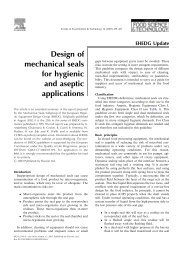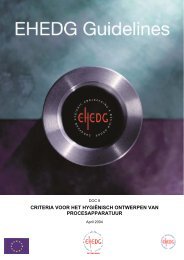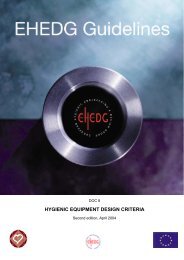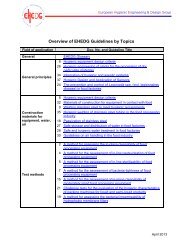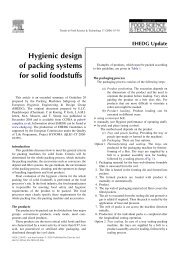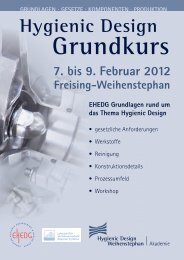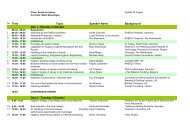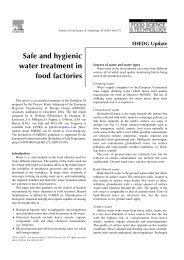Yearbook 2013/2014 - ehedg
Yearbook 2013/2014 - ehedg
Yearbook 2013/2014 - ehedg
Create successful ePaper yourself
Turn your PDF publications into a flip-book with our unique Google optimized e-Paper software.
Performance testing of air filters for hygienic environments: Standards and guidelines in the 21st century 51<br />
Similar to EN 1822, the new international standard ISO 29463<br />
defines the scan test method as the reference method, where<br />
the local and the integral particle collection efficiencies are<br />
measured for the most penetrating particle size (MPPS).<br />
Table 1 defines the ISO filter classes and the related collection<br />
efficiencies and penetrations, respectively. In total, the test<br />
and classification procedure consists of four individual steps:<br />
(1) Determination of the MPPS by measuring the fractional<br />
collection efficiency curve as a function of the particle size on<br />
flat sheet media samples (see part 3 of the standard); (2) leakproof<br />
testing of the filter element (see part 4 of the standard);<br />
(3) determination of the integral efficiency of the filter element<br />
(see part 5 of the standard); and (4) classification according to<br />
Table 1 (see part 1 of the standard). In part 3 of the standard,<br />
the required statistical methods are described.<br />
General ventilation air filters<br />
Coarse and fine dust filters ensure sufficient indoor air<br />
quality in less critical production areas and in general<br />
building and office ventilation. In high care production areas,<br />
cleanrooms and associated controlled environments, these<br />
filters are used as pre-filters to the EPA, HEPA and ULPA<br />
filters. Coarse and fine dust filters are tested and classified<br />
in Europe according to EN 779. In contrast to the testing<br />
of HEPA and ULPA filters, the procedure in EN 779 is a<br />
destructive test method, where the tested element is loaded<br />
with a synthetic test dust known as ASHRAE dust. The filter<br />
classes are determined from the average arrestance and<br />
the average efficiency as averaged over the dust loading.<br />
This standard has recently been revised and published as<br />
EN 779:2012. The main modification in this revision is the<br />
introduction of requirements for the minimum efficiencies to<br />
the filter classes F7 to F9, which gives higher operational<br />
safety to the end users with regard to the particle collection<br />
efficiency of filter elements (Table 2).<br />
Table 2. Class definitions to EN 779:2012.<br />
Group<br />
Coarse filter<br />
Fine filter<br />
G<br />
M<br />
Class<br />
G1<br />
Final test<br />
pressure<br />
drop<br />
Average<br />
arrestance A m<br />
to ASHRAE<br />
dust in %<br />
50 ≤ A m<br />
< 65<br />
G2<br />
250 Pa<br />
65 ≤ A m<br />
< 80<br />
G3 80 ≤ A m<br />
< 90<br />
G4<br />
M5<br />
90 ≤ A m<br />
Average<br />
efficiency E m<br />
to 0.4 µm in %<br />
Minimum<br />
efficiency to<br />
0.4 µm in %<br />
— —<br />
40 ≤ E m<br />
< 60<br />
M6 60 ≤ E m<br />
< 80<br />
F F7 450 Pa — 80 ≤ E m<br />
< 90 ≥ 35<br />
F8 90 ≤ E m<br />
< 95 ≥ 55<br />
F9 95 ≤ E m<br />
≥ 70<br />
To ensure a high confidence level of end users with regard<br />
to the quality and design specifications of fine air filters,<br />
the European Committee of Air Handling & Refrigeration<br />
Equipment Manufacturers (Eurovent) introduced some years<br />
ago a certification program, wherein the main performance<br />
characteristics of the products offered by the participants are<br />
verified by regular and independent checks (www.euroventcertification.com).<br />
On an annual base, the initial pressure<br />
—<br />
drop, the initial and minimum particle collection efficiency, the<br />
filter class, and the energy efficiency class of four randomly<br />
chosen fine filters from the participants’ product range are<br />
verified by independent laboratories.<br />
Figure 1. Eurovent certification mark.<br />
Energy efficient operation of air filters<br />
In the context of increasing energy prices and the imperative<br />
of reducing CO 2<br />
emissions, the energy consumption caused<br />
by air handling units has become the focus of attention. In<br />
an average industrial plant approximately 10-20% of the total<br />
energy is consumed by fans in heating, ventilation and air<br />
conditioning (HVAC) systems. In high care production areas<br />
and in cleanrooms and associated controlled environments,<br />
this percentage is even higher. Approximately one-third is<br />
related to the flow resistance (pressure loss) of air filters,<br />
depending on the size and the design of the HVAC units.<br />
Besides investments in energy-efficient fans and variable<br />
speed drives, for example, the optimisation of the filter<br />
efficiencies used and the use of high quality, energy efficient<br />
air filters is a comparably easy possibility to achieve significant<br />
energy savings. Hence, a reduction of the pressure loss of air<br />
filter systems can make a significant contribution to energy<br />
savings and reduction of carbon dioxide emissions when<br />
used in conjunction with variable speed drives. At the same<br />
time, the air quality targets have to be considered, which<br />
means that ultimately the individual optimum of sufficient<br />
filter efficiency with lowest possible energy consumption<br />
must be found.<br />
To guide the end user to the most energy efficient filter<br />
selection, Eurovent published a new document, Eurovent<br />
4/11, which defines an energy efficiency classification<br />
system for air filters.<br />
Under the assumption that the volume flow rate supplied<br />
by the fan is constant, and hence, does not depend on the<br />
filters‘ pressure drop, the energy consumption of air filters<br />
can be calculated by Equation 1 (Goodfellow, 2001).<br />
⎯<br />
q V ⋅ Δp ⋅ t<br />
W = ⎯⎯⎯<br />
η ⋅ 1000 (1)<br />
The abovementioned assumption is valid if the fan is<br />
controlled by a frequency inverter to operate at constant<br />
volume flow rate q V<br />
(in m³/s). In Eq. (1) W (in kWh) is the<br />
energy consumed in the time t (in h). Since the pressure loss<br />
of an air filter increases with the dust collected during the time<br />
of operation, in Eq. (1) the pressure loss Δp (in Pa) has to be<br />
introduced as integral average value over the time interval t.<br />
The overall electromechanical fan efficiency η depends on<br />
the design and the operating conditions of the fan. Modern<br />
fans can have an efficiency of 70%; while for older models<br />
or when utilised in disadvantageous operating conditions,<br />
realised efficiencies might be just 25% or even lower.



